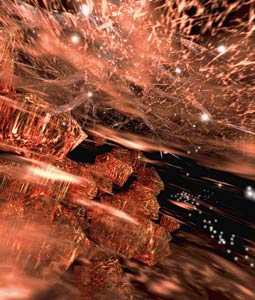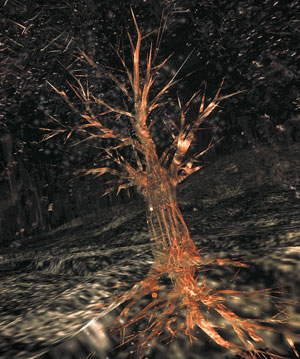In the light worlds of Osmose, Char Davies is expanding the frontiers of virtual reality.
A luminescent forest shimmer around me as I float through the ir. Looking down, the ground is covered with drifts of opalescent leaves, and the air resounds with the quiet strains of an invisible orchestra playing distinctly electronic, but soothingly 'organic' music. In the distance, I see a river of lights wending its way through the forest like a stately stream of fireflies; up ahead is a clearing, in the middle of which stands a large tree. up close the tree's bark glows red, and I can see the juices coursing through its 'veins.' I lean forward again, and pass right through this 'tree of life' — magically transgressing its space, to emerge on the other side of the clearing. The forest shimmers enigmatically as I head toward the river of lights.
Osmose, a newly unveiled virtual reality world created by Canadian artist Char Davies, is an extraordinary synthesis of the technological and the organic; an inspired silicon dream about nature, life and the body. In Osmose, the 'immersant' — as Davies likes to call the VR user — is transported into a luminous landscape centred around a virtual forest. The attempt here is not at Photorealism — Davies isn't aiming a mimesis. Rather, she pays homage to the organic, using state-of-the-art hardware and software to create a richly complex dream-world. The pearlescent leaves, the river of lights, the shimmering splashes of water in the pond, the glowing rocks of the abyss — these might almost be from an Impressionist painter's palette. But if, like Monet and Impressionism's spiritual founder, J. M. W. Turner, Davies finds inspiration in an intimate engagement with nature, she is also obsessed by the evocative power of light itself. Here is a new master of lux for the cybernetic age.
Since she first exhibited Osmose, in August 1995 at the Musée d'Art Contemporain in Montreal she has been inundated with requests to show the work around the world. Industry big guns are also taking note. On the day of my immersive journey, Jaron Lanier — the man who coined the term virtual reality — was due in for a personal guided tour.
The configuration in which I saw Osmose at the Ricco/Maresca gallery in Manhattan included no less than three Silicon Graphics Onyx workstations — currently the Rolls Royce of image-processing computers. There was also a VR helmet a specially designed chest harness for motion control through the virtual space, and a huge stereoscopic video protector: in all, close to one million dollars (US) worth of equipment Only one person at a time could use the VR helmet, and so be immersed in the Osmose world but each person's VR voyage was stereoscopically protected on to a large video screen where it could be viewed by a wider audience. Furthermore, by donning red/green glasses the entire audience was able to see the images in 3-D: a marvellous trick that, while not the same as full immersion was nonetheless a mesmerizing experience.
While I awaited my turn with the helmet I spent hours watching other people's journeys through the Osmose landscape. That it was always some particular person's journey was made explicit by the fact that the immersant stood silhouetted behind a second screen, like a technological shadow-puppet — another way in which Davies incorporated a subtle use of light into the work. The computers themselves could also be seen blinking in the control room behind a glass door. They, too, were participants in the whole Osmose performance.
Unlike many VR worlds, which function almost as puerile games of make-believe, Osmose operates on many different levels. Here technical virtuosity is partnered by not only a unique aesthetic 'but also a subtle philosophical rationale. ln Davies' hands, virtual reality is proving to be more than just a method for realizing the techno-jock fantasies that fill the pages of Cyberpunk novels.
I approach the river of lights, flying slowly through the Osmose landscape When I lean forward I go forward; leaning to the side takes me sideways. The edge of the river appears beneath me and I begin to descend. My body breaches the ground near the bank so that I am now 'swimming' in the earth though, I can still see the river just ahead. I move toward it, clearing the bank, and find myself immersed in the stream of lights. Softly glowing orbs, the lights move straight through me — for like neutrinos, virtual objects can pass through ordinary matter. I press forward against the flow, swooping along the curving channel of the river, searching for the source of the dancing lights.
"Simply stated," Davies says "Osmose is about being-in-the-world, in its most profound sense. It's about our subjective experience as sentient, embodied, incarnate, living beings embedded in enveloping flowing space." Neither a game, nor a mission-oriented adventure Davies views Osmose as an artwork motivated by a desire to heal the Cartesian split between mind and body, subject and object, that has shaped our cultural values"; an artwork that aims at "transcendence of difference through mutual absorption, dissolution of boundaries between inner and outer, intermingling of self and world". In Osmose there is no goal or end point, no puzzle to be solved or mystery to be pieced together. Here, the aim is simply to let the space enfold and unfold around your as you slowly explore the dozen interconnected environments.
It's about our subjective experience as sentient, embodied, incarnate, living being embedded in enveloping, flowing space.
Over lunch Davies explains her deep antipathy to the Cartesian aesthetics and ideology that dominates not only the VR community but also the computer-based entertainment industry. She speaks with a soft voice and on first impressions, seems an unlikely adversary to the might of the techno-establishment. But behind the quiet exterior, Davies possesses a steely determination and a thorough understanding of the industry. In its early years, she was one of the driving forces behind the hugely successful graphics company Softimage, founded by her partner Daniel Langlois. Softimage produces the software used to create many of the world's most advanced animated commercials and films. These days Davies is not just an artist but is one of the industry's elite. Thus she is in the rare position of being able to see the field from both an insider's and an outsider's perspective
In recognition of Osmose's foundations in software, at the very bottom of this virtual universe one can descend into a world of the code itself. Here in a subterranean void — beneath the ground; under the forest — blocks of the actual working code fill the space with line after line of glowing green symbols. As Davies puts it, the virtual space of Osmose is literally 'grounded in the computer text in which it is written. Just as this 'codeworld' resides at the bottom of Osmose, so at the top there is a 'textworld,' a sort of heavenly void filled with blocks of text from philosophical works that have been sources of inspiration to Davies. There are writings by Heidegger, Rilke, Huxley. Joseph Campbell and Gaston Bachelarci, author of the beautiful Poetics of Space. Interspersed with these philosophers are passages from Davies' own writing about her work. In the 'text world,' Gregorian chants fill the air, while the 'codeworld' resounds with digital beeps. According to Davies, these two symbol-based worlds act as parentheses to the overall virtual space. They are a conscious acknowledgement that virtual reality is not 'reality' (or substitute for it), but a highly crafted construction.
Given its complexity, I was astonished to learn that the Osmose team consists of just three people Davies, Harrison and classically trained animator Georges Mauro. There is also a sound designer, Dorota Blaszczak, and a music composer, Rick Bidlack.But all the visual design, modeling and rendering was done by just three people, in only six months. The 3-D models were created by Mauro using commercially available programs from Softimage. Then Harrison's custom software was used to adapt the models for real-time viewing. Davies is proud of the small scale of her operation, for it demonstrates that one does not need huge institutional or corporate resources to create innovative VR environments. At the moment, of course, you do need access to at least one Onyx processor to create an Osmose-like world, but Davies' team is working to adapt its software to run on smaller, cheaper computers. Having no technical training herself, Davies wants to prise VR away from the technocrats and put it into the hands of artists. With computer power rising exponentially, she insists it is only a matter of time before this will be possible.
Meanwhile, she is beginning work on a new VR world — one that will include interactivity. While in Osmose the immersant has the freedom to move around at will and choose their own journey, there is nothing in the world that responds to your presence. You can choose how you see it, but you can't affect it in any way. In the new world, Davies wants to give the user affective power so that there is interaction between them and the virtual environment. Again, it will be an organically inspired universe, building on the philosophy and aesthetic she has established with Osmose.
The world-within-a-world in the white bubble recedes into the distance, and I am inextricably drawn back through the starry 'sky,' as if by the power of some virtual gravity. My Osmose journey is ending as the luminous environment fades out of sight around me. I take off the helmet and pause for a moment in the control room: I have visited another world and come back to tell the tale. Humankind may be giving up on the dream of outerspace, but, after seeing Osmose, I suspect that the potential of 'inner' virtual space may be limited only by our imaginations. Along with Davies, I hope this power soon becomes available to artists everywhere.
This article may include minor changes from the original publication in order to improve legibility and layout consistency within the Immersence Website. † Significant changes from the original text have been indicated in red square brackets.



